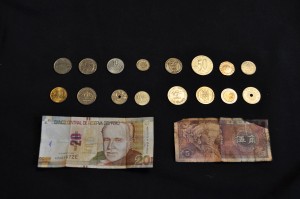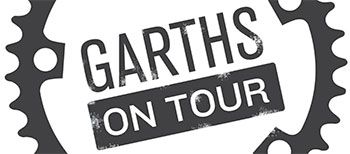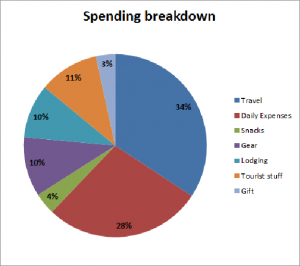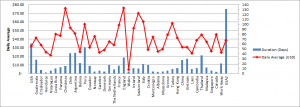So… today’s blog post breaks into territory surely all have wondered about, and more than a few have dared to ask about: THE FINANCES.
How much did it cost? And implied within that question are others… how could you possibly afford that? Did you win the lottery? Did you inherit a family fortune? Are you working from the road? How do you access your money? The questions roll on. So now we make our best effort to answer.
A disclaimer on the front end: a bicycle tour is exactly what you make it. You could do a trip the same time and distance as ours, and could spend half or twice as much. It’s all about the choices you make along the way. Pretty early on, we decided a couple of things, which in turn heavily influenced our long-term budget.
First of all, we were willing to spend more money to really “see” a place. We valued fully experiencing the places we did go rather than trying to make the list of places we had been longer. As time went on, this decision meant we would have to table places we really wanted to go, like Australia and New Zealand. But we didn’t want to look back and feel like we hadn’t actually experienced the places we went. This decision contributes to some big-ticket items on our budget, like hiking the Inca Trail to Machu Picchu, rafting the Futaleufu River in Chilean Patagonia, or doing a full-day tour of the war beaches in Normandy, France. Our initial budget for the Tour was roughly to average $50/day for 2.5 years. Because of this decision to maximize our destinations, we figured the time would be closer to two years. We were OK with that, and now, looking back over the course of our journey, we DO NOT REGRET those decisions we made!
Secondly, we enjoyed regular treats along the way. Cycling can be hard work, and having a fun snack or dessert helps give you something to look forward to some days. In South America, we had plenty of ice cream. In Europe, we drank lots of hot teas and cappuccinos. In Asia, we got our fair share of Cokes. And in the US… well it was a lovely combination of all those! Now, none of these items are actually that expensive when bought individually… but over the course of a two-year trip, these purchases add up. But we decided that was worth it to us.
All this to say… could we have done the trip for less? Absolutely. So this summary is simply a reflection of what we spent. If you’re planning a cycling trip of your own, you can use this as a guide, but don’t let it inhibit you. Don’t think that if you don’t have this much money that you couldn’t do an equally cool or even cooler trip… but also remember that you can always spend more!
So, the first statistic that surely everyone wants to know!
Overall cost of the trip*: $47,712.65
Let’s talk about that for a minute. For us, this number covers EVERYTHING we bought from the day we set out (August 18, 2011) to the day we finished (September 28, 2013). It does NOT include gear purchases made before the trip. But it does include our flights, medical insurance, gear replacements and daily expenses. In fact, here’s a graph that sums up the percentages, and below, an explanation of each of the categories.
*All costs are in U.S. dollars.
Travel: Travel is any transport we paid for when we were not riding our bicycles and other fees or costs generally associated with travelling. So, that is all the flights we took (and the horrid baggage fees that accompanied them), ferries, trains, buses, taxis, and also our global medical insurance. While we primarily traveled on our bicycles, connecting a few dots here and there is inevitable. This category covers all of those.
Daily Expenses: The biggest chunk of this category was groceries; food that we bought that would be prepared later. But other things got looped in here, like eating out, toiletries, or gas purchases for our camp stove.
Snacks: I mentioned above that we would stop and get “treats” along the way. We wanted to track how much extra that cost us, so we separated it from our daily expenses. But understand, these were not always snacks… sometimes it was dessert or a drink after a meal in a big city, or a cold Coke from a small store in the middle of nowhere.
Gear: Again, these expenses do not include pre-Tour purchases. This is the cost of gear replacements and repairs we made along the way. Honestly, this number was a big wild card in our budget. We paid good money on the front end to get quality gear, because we knew that would pay out over such a long trip. What we didn’t realize was that even the GOOD gear isn’t cut out for what we did to it. So we had not planned on spending nearly this much on gear, but that is simply part of a long cycling trip.
Lodging: Any paid accommodation goes into this category, from campgrounds to hotels to hostels… and anything in between.
Tourist Stuff: This included tourist activities (like the rafting trip we mentioned earlier) and also souvenirs we bought along the way (we tried to get a small something from each country we visited).
Gift: As a general rule, we have some philosophical problems with giving outright to beggars on the street. But we do believe in helping people, and would sometimes try to offer to buy someone a meal or help meet a specific need.
So, some fun statistics to summarize:
For a couple—
Cost per mile: $2.08
Cost per kilometer: $1.29
(So… for a single, it could plausibly be well under $1.00/mile for a fantastic journey. Not a bad value!)
Daily Average: $62.05
Daily Average w/o additional travel costs: $40.78
Here is a breakdown of what we spent in each country. (By the way, you should know that Dave is the Excel mastermind when it comes to all these awesome graphs. He’s brilliant!) This one has lots of detail, so I recommend right clicking on the graphic and selecting “open in new tab.” Then it will come up separately, but a lot clearer. The list across the bottom is all the countries, in chronological order of when we were there.
Some thoughts on this graph: Not every number that goes with each country is truly representative of the cost of normal bike touring there. For example, Chile is more expensive than other countries in South America, but not THAT much more. Our costs for Chile were much higher because we paid for a lot of extra transport there, like a bus and a ferry, just to get to our starting point way down south. Similarly, Peru is actually very affordable (cheap, even!), but our costs there were higher because of our organized Inca Trail hike. Guatemala is one of the least expensive places we traveled, but we paid for two weeks of language school there. You get the idea… for the most expensive countries on this chart, there is usually a particular reason you can pinpoint.
I do feel I should address our two highest averages, since, in comparison, they seem almost unreasonable. Christmas was the 12 days in 2011 we were back in the U.S., between Central and South America. We actually spent almost no money on basic expenses, since we were staying with family. But we did some major gear replacements and upgrades while there, knowing it would be easier to get those things in the US than in South America.
England is not so different. We paid for some medical testing in England, which bumps the average a little. But the real kicker is the upgrade we made on our rain gear. We spent more than $800 in one day just to purchase Gore-Tex rain jackets and pants. This was a purchase we carefully considered, but we knew Gore-Tex was the best and would be worth it in the end. We did some other gear upgrades in England as well, and that is also the time we began significantly improving our diet. So, please don’t just look and assume that England is the most expensive country in the world. It is pricey, but not THAT much pricier than other places!
One more thing worth noting: we met my aunt in Wales and she treated us to everything! So no, Wales is NOT that cheap! Ha!
As for the other countries, there are small discrepancies and exceptions that do not exactly represent how much it would cost for an average bike tour in that country. However, it at least gives you a general idea. If you are planning a bike tour and would like more details, or if you’re just generally a curious person, feel free to contact us for more info: garthsontour@gmail.com
Also, as far as logistics for our money, we did all of our banking online, and used ATMs wherever we were to obtain local currency. For some stretches in Europe or the US, we used our credit card (which we would pay off online each month). But for the most part, we felt a “cash only” system kept us more aware of our budget. We kept only a little cash ($30-$40 worth, enough for one or two days of normal expenses) in our wallet, and might have up to a week’s supply buried deeper in our panniers.

Some of the leftover cash in random currencies from around the world: Peruvian Soles, Chinese Yuan, Danish Kroner, Swiss Francs and more!
Most people are surprised when they find out how little it can actually cost to do a trip like ours. And like I said before, you could easily do it for more or for less. Or maybe you’re thinking… “Geez, that’s a lot of money!” But do remember, it cost us LESS to travel like this for two years than it would have cost us to live at home in Auburn, Alabama, for the same time period. Altogether, traveling by bicycle offers excellent value for your money! Yes, we had to live frugally for years before we left to save for this trip. We didn’t have cable TV or smart phones with data plans, we drove cars that were paid off, and we rarely ate out. But again, we’d say it was definitely worth it!
End note: We believe these numbers are close, although not 100 percent accurate. We carried with us everywhere a small notebook, in which we recorded EVERY purchase we made. So, even though I’m sure we missed a few along the way, these numbers are, at minimum, a fair representation.



6 comments
Shelby says:
Oct 25, 2013
Unreal Beth. What an amazing life adventure!!
Kevin Beasley says:
Oct 25, 2013
fascinating article! definitely scratches an itch for the curious! Thanks.
Kevin Beasley says:
Oct 25, 2013
hope you address the other questions in paragraph 1 later. how did you afford it, did you win the lottery, etc…
francis says:
Oct 25, 2013
good article thanks. As Kevin, I would also love to know how you did afford it, but I guess the answer is the same as most: you just had the courage to go with whatever saving you had at the moment and decided to enjoy life regardless of what comes next.
bgarth says:
Oct 26, 2013
Yes Doug–that’s exactly right. I tried to (briefly) discuss that in the last paragraph of the post… we lived below our means for years. We bought an inexpensive home that we “fixed up,” we drove vehicles that were paid for, we had no debt, and we didn’t have cable or eat out much. Years of diligence in that kind of savings really pays out! There was no gold mine or lottery win or inheritance. Just simple living.
Doug W. says:
Oct 25, 2013
Congratulations on finishing your tour! Thanks for the great info and careful explanations on each of the categories. My wife and I are headed out in April for a similar 2-3 year tour and, to answer Kevin’s question, we’ve been saving for roughly 7 years. No lottery, no organ selling, no inheritances. Just living below our means and saving, saving, saving. Started out just $200/month savings 7 years ago as we paid off bills, and now we’re up to over 10x that per month with no debt aside from the house we’ll be selling before we leave. I always tell everyone who asks, deciding to do this trip was the best financial move we ever made.